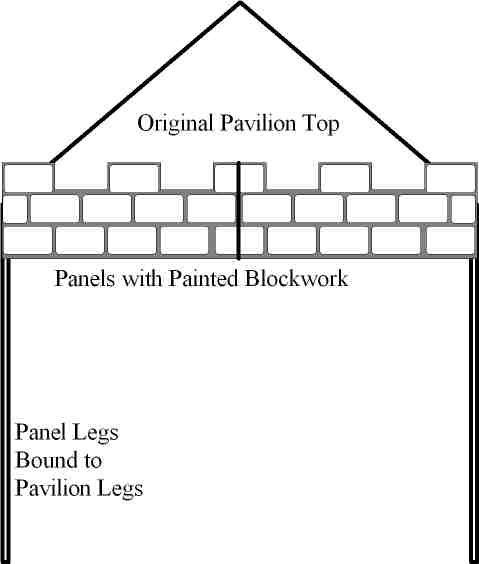
Earlier versions of this article appeared in the January, 2006 Cactus Needles, the January, 2006 Connotations, and in my collection, Yardstick and Chalk: Randwulf's Ramblings on Costume Volume 2.
This page is a work in progress. I intend to add pictures and
descriptions of clever tent disguises as encountered at
different faires. Unfortunately, the links must be pruned now
and then as web pages go away.
Open-sided pavilions were indeed used in the middle ages. A
noble couldn't be expected to be exposed to the hot sun while
enjoying a tournament or directing a battle. One type, called a
"baldachinum" was a cloth stretched between four poles. These were
seen in period art being carried by four servants over some
dignitary's head in a procession. They have developed into
permanent features of church architecture.
What is it about pop-ups that makes them look too modern for us rennies? I see three condemning characteristics:
--Overly sharp or square lines
--Modern framing materials (especially shiny aluminum or steel)
--Synthetic fabric tops.
All of these are fairly easy to disguise.
The Castle
One of the easiest disguises to build (especially if you don't sew) involves making your pavilion look not like a pavilion at all, but a castle tower. Cut panels of lightweight plywood to cover the lower portions of the tent top. The upper edges of the panels are cut into crenelations like a castle wall. Paint the panels to resemble stonework, apply faux bricks, or start out with faux brick paneling. Support the panels somewhere above the bump-your-head level with wooden legs and bind these legs to the legs of your pavilion, helping to conceal the metal.
For convenience of transport, make the panels in two sections (left to right) for each side of the pavilion, for a total of eight panels on a four-sided pavilion. These flat side panels make a good surface to display signs and heraldry for your business, guild, or performing troupe.
The castle panels work best on a pop-up with vertical legs. It would be much more difficult to fit them to a pavilion with splayed-out legs.

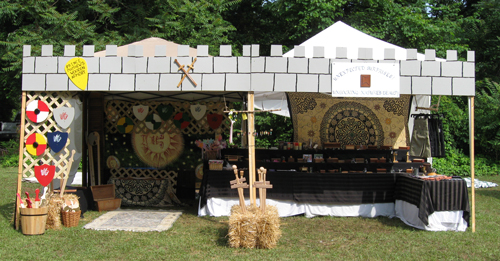
Castle design used by Pat Donovan Designs, makers of dream boxes
and other wooden delights.
Another no-sew option is to drape your pavilion with pieces of cloth or greenery pinned together. This can be put together quickly for your first event. I've seen a belly dance performing troupe do this with bright colored lamés and satins on the outside of the pavilion and carpets and cushions inside. The result looked kind of like the inside of Jeannie's bottle. Very effective.
Another performing troupe created a faerie bower effect by
wrapping the pavilion legs in flower and leaf garlands and draping
the top with artificial leaves and flowers.
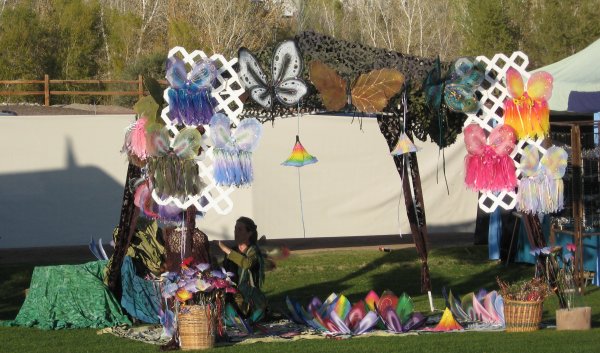
Sylvanwoods, purveyors of fairy wings seen at the Two Rivers
Renaissance Faire in Yuma, drape their pavilion with special
camoflage netting.
The most extreme example of the drape disguise I've yet seen involved a merchant who had no pavilion at all. He had signed up for the faire at the last minute and had never done a medieval event before. Fortunately, he was a dealer in oriental rugs. He covered his van and tables with the carpets. I don't think the guests knew he was hiding an entire vehicle. On the other hand, I don't think the park staff were very happy with the wheel ruts.
My favorite disguise method is to build a new cloth outer shell which covers the original tent frame and shell. The shape of the over-shell should mimic the pyramid shape of the original shell, with four extended triangular side panels.
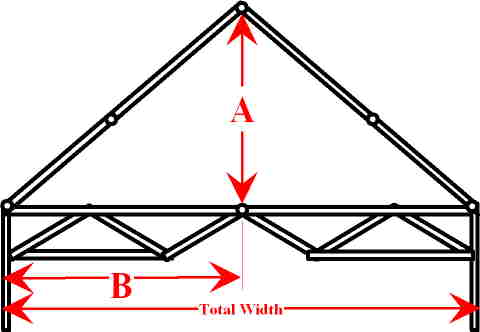
First, measure your pavilion. You'll need the total width of each
side. Surprisingly a nominal 10-foot pavilion is only about 117
inches on a side, three inches short of ten feet. This is a good
thing - it makes suitable fabric easier to find. Take this figure,
divide it in half, and add one inch for seam allowances. Call this
the base "B". On my tent 117 / 2 + 1 = 59.5 inches, conveniently
just less than a standard 60-inch bolt of fabric. I rounded my B
figure up to 60 inches to make cutting simpler.
Measure the distance up the middle of one side of the roof from its horizontal support to the peak of the tent. Call this the altitude of the triangle "A." On my tent this is 67 inches.
Measure the length and circumference of the legs. Save these figures for later.
Lay out four layers of fabric. Each layer's length should be equal to A plus one yard. The extra yard allows the panel to hang down below the edge of the triangular portion of the tent roof, completely concealing the original tent roof.
Measure one-half yard from each end of the fabric and draw a diagonal line as shown. Cut through all four pieces of fabric along the diagonal line as shown. You now have eight pieces of material shaped like a triangle with one extended side.
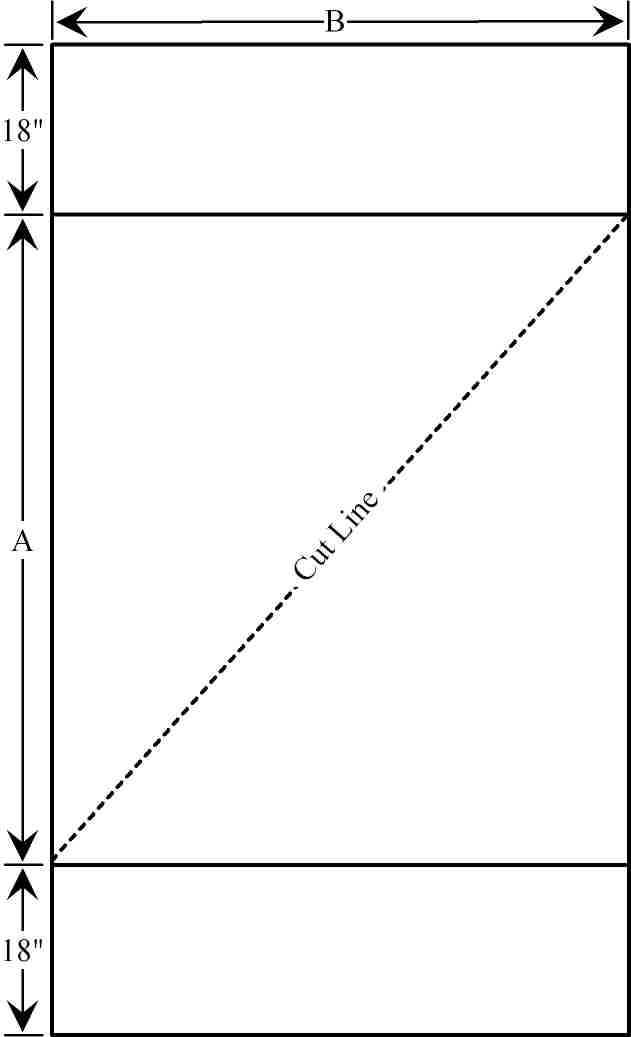
Sew the pieces together straight-side to straight-side and bent-side to bent-side to form a pyramid-shaped tent top.
Finish the bottom edge of your new tent roof. This provides an opportunity to make the tent look much more medievalish. You can finish the edge with a fringed trim, available from upholstery stores.
My favorite edge finish is to cut the edge along curves to form "dags." There's nothing that looks more medieval. Dags can be any shape and those found on clothing became very complicated indeed. I make my dags by building a half-circle pattern about 12-inches wide, then using the pattern to lay out cuts evenly spaced along the tent edge, as shown. Once the dags are cut, finish the tent edge by turning under and sewing.
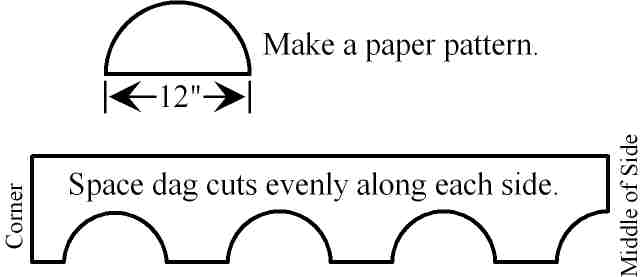
Mount grommets in pairs at the corners of the corners of the tent shell. Suitable grommet kits are available at upholstery supplies stores and camping stores. Pass cords through the grommets to tie the tent over-shell to the tent legs.
The pyramid-shaped over-shell described above requires about
11.5 yards of 60-inch wide fabric to make. You have many choices
of fabric. If you leave the tent's original shell in place
(concealed by the over-shell) your fabric does not have to be very
heavy since it does not have to support all of its own weight. My
first over-shells were made from used bedsheets and lasted for
years. There's an old SCA trick that involves building a pavilion
from a military surplus training parachute. (See https://www.instructables.com/Parachute-Shade-Structure/
)
Your fabric should have a natural look. The whole point is to cover up that plastic-looking material the tent came with. Broadcloths, twills, and triggers are suitable. I've done well with the sportswear solids that turn up in spring clearance sales. Your material should be able to take some sun and rain without the colors fading or running.
Machine-washable is a good characteristic for you fabric, but may bow to other considerations. For example, I know a greyhound adoption group that uses a beautiful shell built from two contrasting colors of upholstery brocade with the same weave pattern. The use of two or more colors for adjoining panels is called "particoloring." It's another feature that screams medieval. I used alternating panels of blue and yellow to achieve this effect on my own pavilions.
What do you do if your favorite fabric is not available in 60-inch widths? You'll have to alter the pattern. You can insert a triangular gusset in the middle of each side of the roof, or you can run the fabric sideways and divide each panel into top and bottom portions. This will take a bit of strategy, different for every project. You will need to apply the measurements specific to your tent and fabric width. It's best to do the math before you buy the fabric.
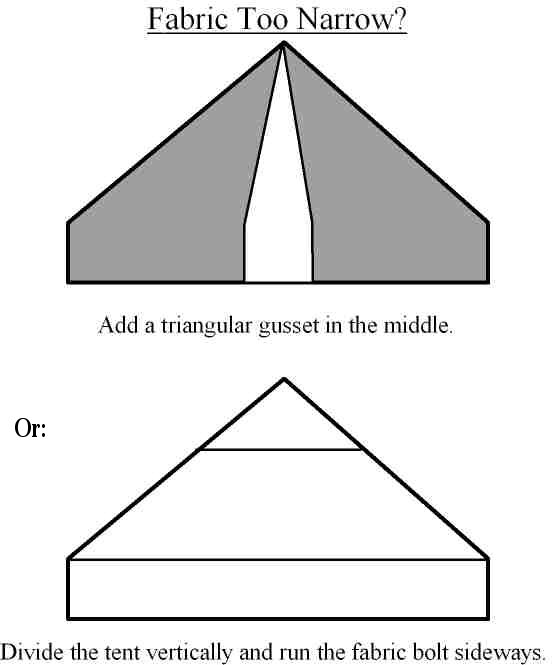
If they look too metallic, the legs of your pavilion should be covered. The simplest way to do this is to build "leg warmers." Cut four pieces of fabric equal in length to the legs and a bit wider than the circumference of the leg. Finish the ends of the fabric strips and sew the sides together to form a long tube. Add some cord to one end so the leg warmer can be tied to the tent frame.
Some types of pop-up have long extensions to the shell that run down the legs. If your tent has these, you should mimic their shape by making long rectangular extensions at the corners of your over-shell. These are tied around the outside of the legs with cords.
As mentioned above, you can cover your tent legs with leaf and flower garlands from florist supply companies.
I don't worry very much about the portion of the frame covered by the tent roof, but others choose to conceal these frame parts by draping fabric inside the tent. I would not recommend this if you use hot lanterns inside the tent.
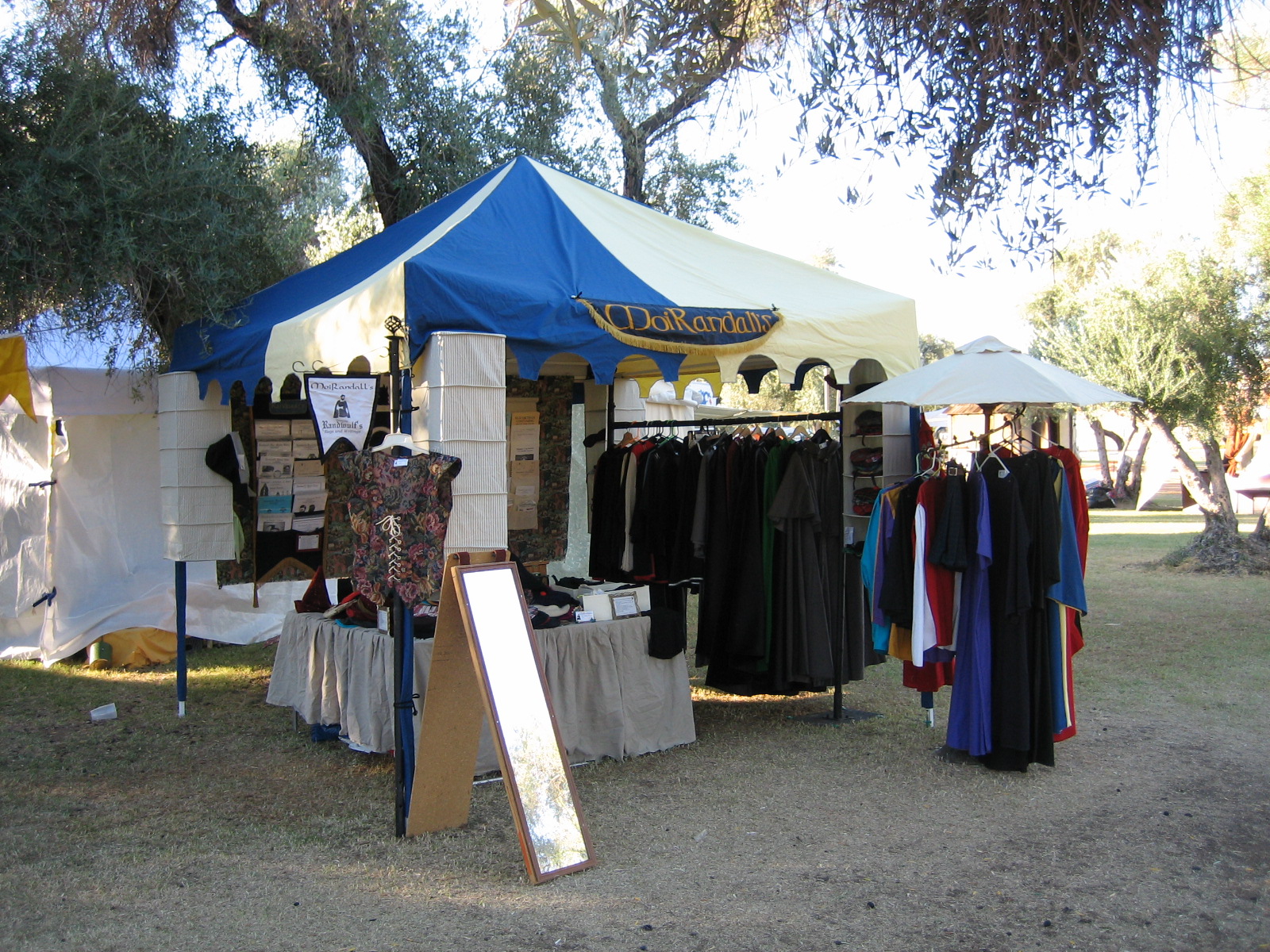
The MoiRandall's pavilion, seen at the Devonshire Renaissance
Faire in 2005.
While your pop-up was built to be open, there are often good reasons to close off one or more sides. You may wish to form a blank display wall; to separate your pavilion from the next one down the row; or to provide extra shade when the sun is low.
To make a sidewall, you can use the same material you used for your over-shell. Cut two segments of 60-inch wide fabric to a length equal to the height from the ground to the edge of your tent frame. If you particolored your over-shell, you should particolor the sidewalls with the same color. Sew the long sides of the material together to form one panel. Finish the raw edges by turning under and sewing.
I suspend the sidewall from the inside of the tent frame using medium or large-size binder clips, which are available from office supply stores. You can also mount grommets in the top edge of your sidewall and hang it from the tent frame with segments of cord or shower curtain rings.
Tablecloths and sturdy window drapes can also be used for sidewalls. I made one sidewall from a tapestry brocade with a repeating pattern of caravans, troubadours and maidens in towers. (Quite appropriate for the faire). The fabric is not quite broad enough to reach the ground, so I use it along with a plain fabric sidewall.
Beware: Sidewalls are like sails. They grab the wind and exert pressure against the tent frame. Your pop-up probably doesn't have guy lines for horizontal bracing like a tent meant to have sides. I deal with this by not staking down the bottom edges of my sidewalls. If the wind picks up, the sidewalls simply rise and relieve the pressure.
There are a tremendous variety of pop-ups available these days at a wide range of prices. The following are strictly my personal opinions. Your mileage may vary.
You can have a small plastic-framed unit for as little as twenty dollars. In my opinion, these low-end plastic and thin aluminum frames are not worth the trouble. They're okay for a beach trip, but not for the faire. They will not last long and will break if subjected to very much wind.
My favorite pop-ups have enameled steel frames connected with clever pantographic joints that allow them to be collapsed into a single bundle. The steel has more mass than an aluminum frame, which improves its stability in the wind. On the downside, the steel-framed tents are heavier to carry. Some of the current models have wheels built into their carrying cases to help with this. Prices on these range from about $80 up to about $300. Generally, the price has come down over the past few years.
I prefer frames with solid rails up from their corners to the top, rather than a single center pole. This arrangement places less stress on the canvas and droops less in the rain.
I prefer a minimal number of joints in the side rails I've seen the sides that look like a row of X's torque over in the wind and cause one corner of the tent to collapse. On the other hand, that particular tent owner may not have set it up properly.
Pop-up tents are easy to find. You can purchase them at home improvement stores like Home Depot and Lowes; sporting goods stores like Big 5 and Cabela's; discount stores like Wal-Mart; ; and membership warehouse stores like Costco and Sam's Club. Even the larger supermarkets carry them seasonally. You will find the most choices in the spring, when people are gearing up for picnics. Clearance sales may come later in the year.
There are many sizes to choose from. Other portions of this page focus on the 10 by 10-foot nominal size, which is a good choice for typical-size faire spaces.
In recent years, some of the manufacturers seem to have caught on to the needs of their renfaire customers. At least one model comes with a natural-looking tan shell material and dagged edges.
There are several other kinds of tents that can be adapted for renfaire pavilions:
Lawn Gazebos
These have pyramid-shaped canvas roofs like pop-ups, but they have heavier frames without the folding joints. They are meant to be set up in your back yard for months at a time. The side frames are made of ornamental twists of metal with oxide or enamel finishes. They look good enough for the fair without any alterations, but they are more expensive and take longer to assemble.
One variation I saw a while back is called a "Barzebo" from D.C. America. It has a built-in counter and shelves for serving drinks. This could be a ready-made shop for a perfumer, jeweler, or other dealer in small goods.
Frame Kits
Sets of prefabricated joints can be purchased at home improvement
stores. These joints are made to fit 2 by 4 or 2 by 2 lumber
stock. You can build your own custom frame and a canvas cover to
fit. These wooden frames will be heavy, so they're very stable in
the wind but harder to transport. This system might work very well
for longer-lasting faires. I bought the frame kit seen above
several years ago, but haven't done anything with it yet.
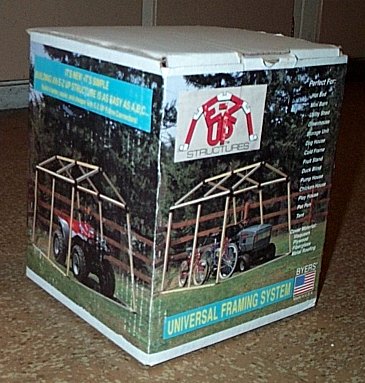
Prefabricated Carports
Prefabricated enameled steel frames can be purchased at home
improvement and discount stores. These usually consist of eight
bent "A" shaped frames connected by horizontal bars above head
height. Sometimes these come with a plastic canvas skin secured
with bungees. The package illustration usually shows these being
used to build a weather cover for a car or RV. You can use two,
three, or all four frames to build tents of custom length. I
suggest building a custom skin for the frame from heavy,
natural-looking canvas with dags.
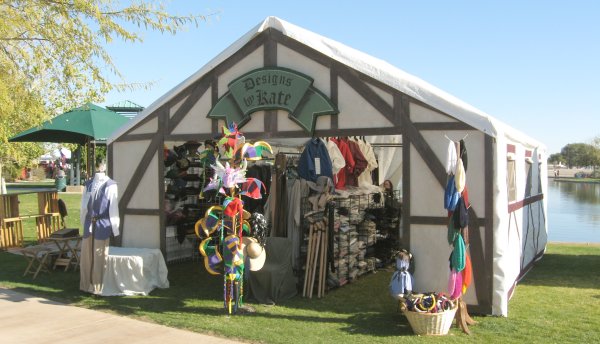
Costumers Designs by Kate started with a
prefabricated carport kit, then added wood and canvas stage flats
with textured paint to the front wall to create a tudor cottage
look.
Umbrellas
Beach or market umbrellas suitable for small displays can be purchased at import stores, garden stores, and swimming pool accessory stores, though they usually aren't any less expensive than pop-ups. These can be used unaltered if they have wooden frames and natural-looking fabric covers. If not, covers and sidewalls can be built around them. Supported from a single center pole, umbrellas can be a bit unstable in the wind. A guy line system might be built into sidewalls for better stability.
I use a four-foot umbrella over my bronze clothing display rack
when there isn't room inside my main pavilion. (See photo under
"Leg Covers.")
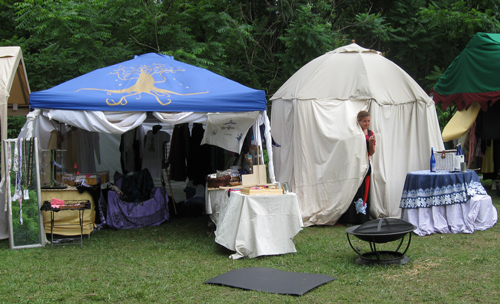
Majickal Things, artists who paint upon fabrics and faces, used a
specially painted cover over their pop-up (left) and an umbrella
fitted with a tent cover (right).
Swap Meet Shades
Finally we have the much-maligned shades built from galvanized
steel electrical conduit. These dominate at swap meets and
prefabricated joints in many shapes can be purchased from swap
meet merchants or tent and awning suppliers. These frames are
strong and stable, but can be ugly. They're okay if you cover or
paint all of the metal parts and use natural-fiber fabric covers
instead of blue plastic swap meet tarps. The larger-size
prefabricated joints can be used with wooden poles instead of
steel pipe. Most of the joint systems are designed for a flat
roof, which doesn't turn the rain very well. You can form a pointy
roof by building a square outer frame and adding a center pole.
See The
Halfling Pavilion for a sample project using these
prefabricated joints to cover a small dome tent.
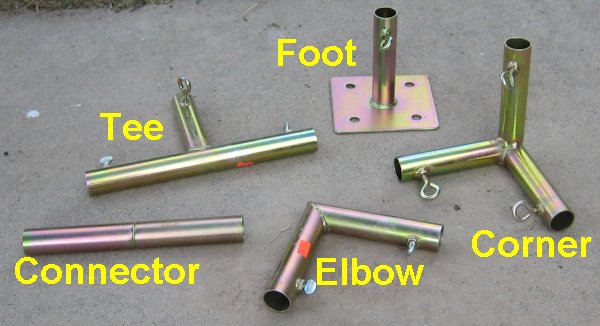
Here are pictures of some cleverly modified pop-ups seen at events around Arizona. I'll add more pictures as I visit more events.
If you've built your own pop-up disguise, please send pictures!
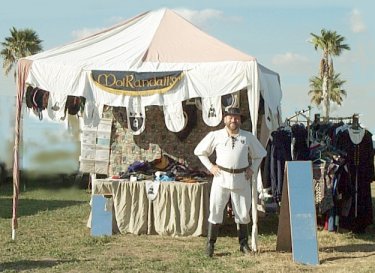
Seen at the Estrella War in 2001, this is my old pavilion cover.
It's made from used bed sheets and features dags printed with line
art. Half of the sheets were dyed brown for a particolor effect.
The brown dye faded to tan after a few seasons. The leg covers are
rectangular extensions from the corners of the roof, tied to the
tent legs.
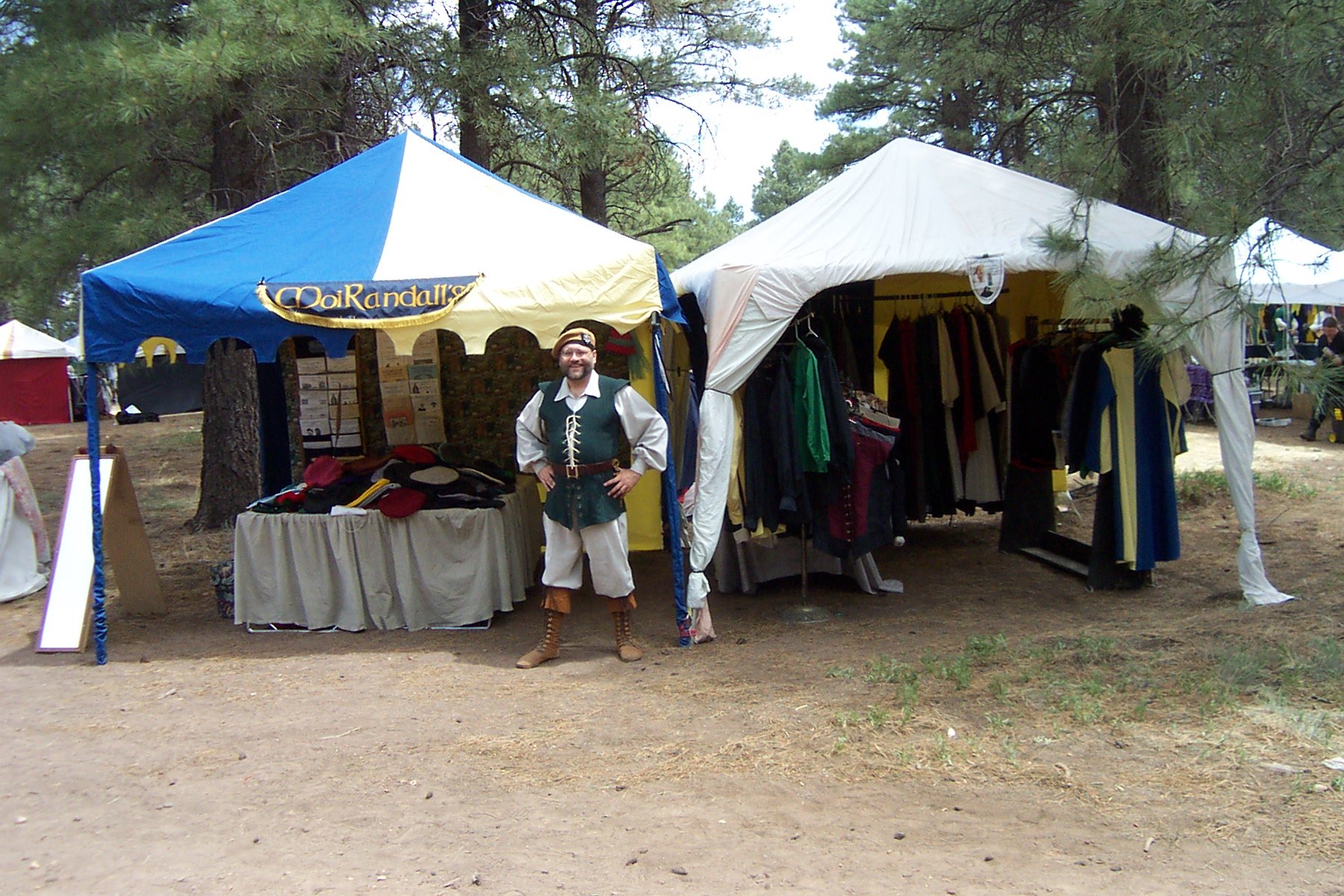
For contrast, here is one of my old bedsheet covers, seen next to
my newer, dagged cover at Renaissance in the Pines in 2004.
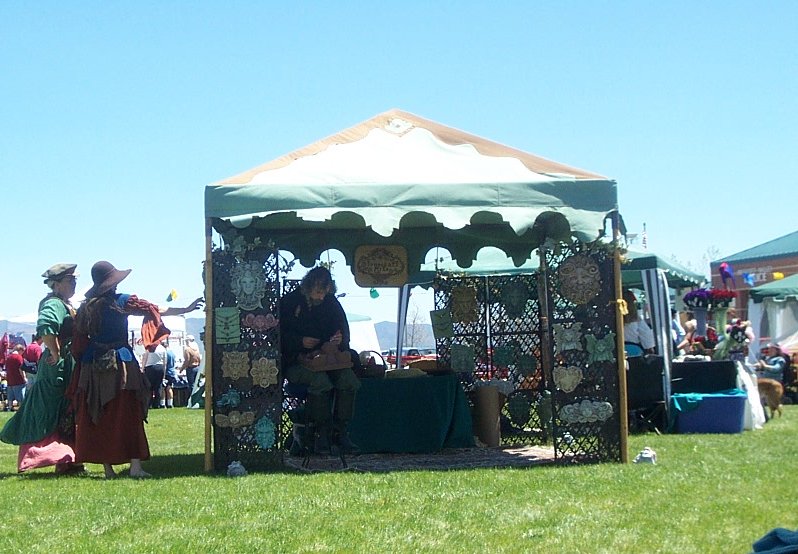
This is a beautiful example of a custom-made cover, seen at May in
the Meadows in Prescott Valley, Arizona in 2004. Note the complex
shape of the dags and the scalloped edges of the brown cloth
panels used to reinforce the edges of the pyramid-shaped top. The
frame is not a pop-up. It's made of wooden poles with steel pipe
joints. The tent belongs to Stonecraft Arts, makers
of marvelous cast stone gargoyles, greenmen, goddesses and other
statuary.
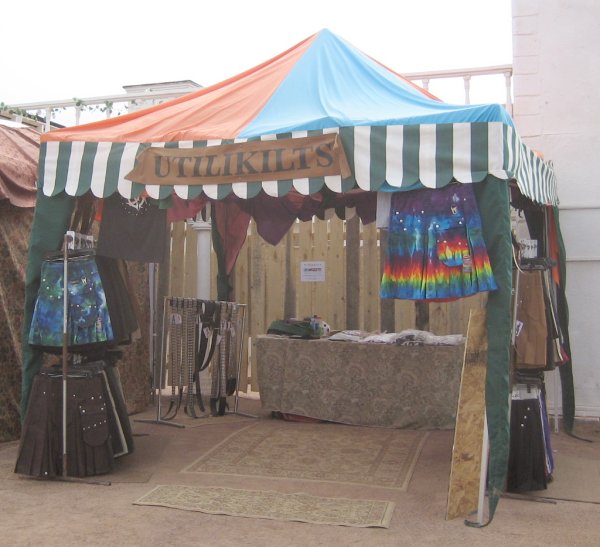
This cover was seen at Arizona
Renaissance Festival in 2006. The tent belongs to Utilikilts, makers of solid kilts
with pockets. The disguise consists of a particolored cover, a
separate dagged strip of striped fabric around the sides, and
triangular leg covers over an EZ-UP brand pantographic frame. The
interior frame members, not seen in this view, have been wrapped
in cloth.
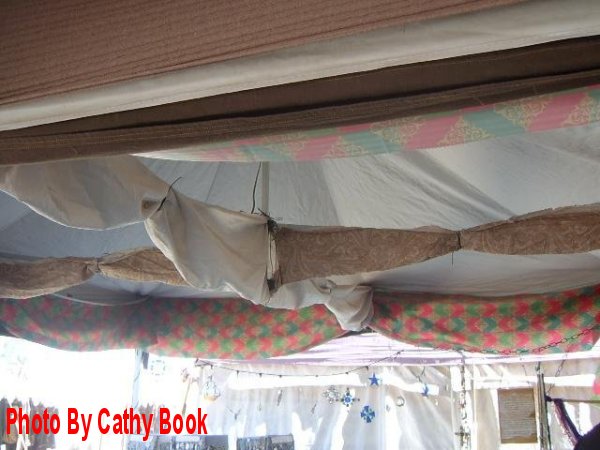
Here is an example of draped cloth used to conceal frame parts
inside the tent. The pavilion belongs to Flying Skwirl, who sell belly dance
costume accessories, jewelry, and kaleidoscopes. It was seen at
the Estrella War in 2006.

Stefan d'Gascon of the SCA Kingdom of Meridies used a bit of vinyl
tape to give the sidewalls of his pavilion a tudor cottage look.
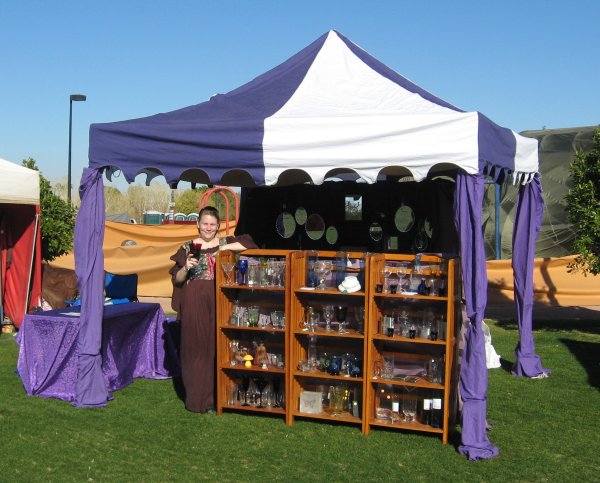
Happy Magpie, creator of custom
etched glass designs, seen at the Two Rivers Renaissance Faire in
Yuma, Arizona. This is another of Randall's particolored tent
covers.
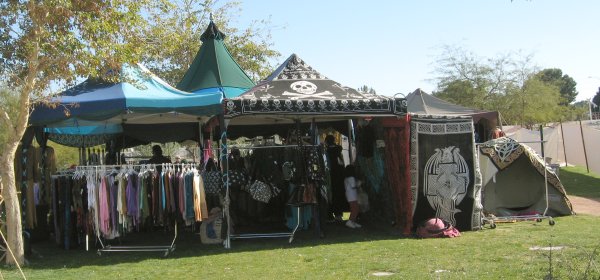
Eye Scry Designs, seen
at the Two Rivers Renaissance Faire in 2008, built a tent cover
from a printed tapestry to go with their pirate-themed
merchandise.
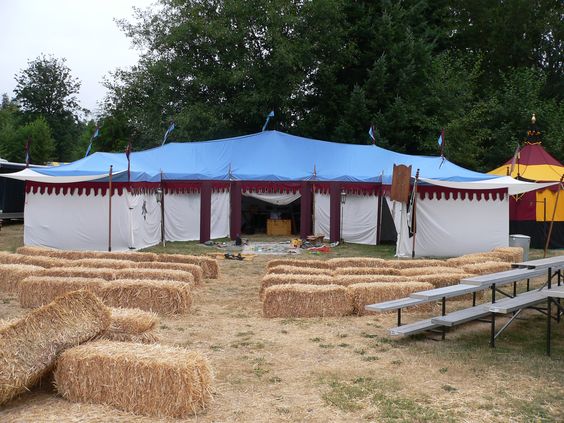
This is the most wonderfully ambitious pop-up project I've seen
yet! Royal Majick, masters of stage magic in both senses of
the word, have built a complete portable outdoor theater by
linking together five pop-up frames under a common roof and walls.
How do you find the book? You can purchase it from MoiRandalls or directly from Mr. LaTorre at http://midtown.net/dragonwing/default.htm.
The Dragonwing site also includes a fine short article on building your own pavilions at http://midtown.net/dragonwing/diy.htm .
Randall Whitlock, known within the Society
for Creative Anachronism as Randwulf Witlac of Axed Root, is
a part-time costume maker, displaying his creations at faires
around Arizona and on his MoiRandall's web site.
Randall designs and publishes the Randwulf's line of sewing
patterns. Randall has served as Newsletter Editor and Webmaster
for the Southwest Costumers Guild
and has directed the masquerades at several central Arizona
science fiction conventions, including the first North American
Discworld Convention in 2009.
Return to Southwest Costumers Guild Web Site.
Return to Southwest Costumers Guild's How-To Articles.
Return to the MoiRandall's Web Catalog.
Check out the Two Rivers Renaissance Faire site.Check out Medieval
Fantasies Company, organizers of renaissance faires in the
Virginia area.
Check out the Central Arizona Speculative Fiction Society, host of CoKoCon and historic CopperCons.